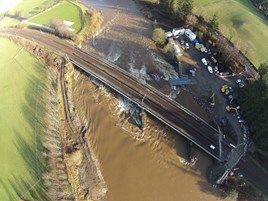Lamington Viaduct was “in a total state of collapse” before being rescued from the waters of the River Clyde, reports the leader of the repair project.
Speaking exclusively to RAIL, Network Rail Route Delivery Director Stewart MacPherson revealed that “the bridge would no longer be here” had work to fix it not started promptly after defects were first reported on New Year’s Eve.
He added that engineers have now won the race against time to prevent the bridge’s complete collapse, despite the scale of damage proving far worse than initial assessments had indicated.
The problems at Lamington first surfaced on December 31 2015, when a passing train driver spotted a dip in the track above pier two (the piers are numbered one to three from the bridge’s southern end on the right-hand side). Track maintenance staff investigated, and all services were suspended once missing masonry was spotted just above the waterline.
“Storm Frank created a torrent of water, and flows were so large that water came up almost as high as the bridge deck,” said MacPherson.
“We immediately began placing rock armour around pier two, but at that stage we did not know the extent of the damage.”
- For more from this exclusive interview, read RAIL 793, published on February 3.















Comment as guest
Comments
FrankH - 29/01/2016 12:55
It's taken years to cause the erosion of the mortar between the stone blocks, it would have happened without the storms, eventually.
Reply as guest
Jimmy - 04/02/2016 15:40
It was stated by a NR senior manager(Mr MacPherson ?) on tv that "this bridge has lasted for over a 100 years & will last for another 100 years once it gets repaired" This viaduct was replaced around 15 years ago for the introduction of the Pendolinos on the west coast main line.They never bothered replacing the Victorian sandstone piers.As Frank has mentioned,this hasn't just happened because of the recent storm.
Reply as guest
FrankH - 05/02/2016 13:52
It makes you wonder how many other similar structures are there and what state of repair they are in. It's the bit underwater that gets eroded a lot faster than that above, and that's the problem because you never see it. NR could have an awful lot of work to do.
Reply as guest
Stephen - 09/02/2016 20:22
Come off it! Several weeks to repair this bridge. It's just not good enough. I am now forced to fly, which is ecologically unsound (if a good bit cheaper). Shambles.
Reply as guest
FrankH - 11/02/2016 16:12
It's virtually a complete rebuild apart from the bridge deck, encasing the pillars (3) in concrete. The water has to be stopped flowing around the pillars, framework built in situ then concrete poured into the frame. Only 1 pillar a time can be done, the concrete has to have time to set and dry out thoroughly then probably a waterproof membrane of sorts will be applied to the pillar. At 3 weeks a pillar it's not bad going in this awful weather.
Reply as guest
Steven Foster - 12/02/2016 23:53
The main train operating companies did not produce a printed (amended) time table in printed form given out at stations on WCML. Virgin did an online TT, which could (obviously be downloaded etc).Surely a printed TT should have been made available at any station serviced by WCML, given extended duration of closure.
Reply as guest